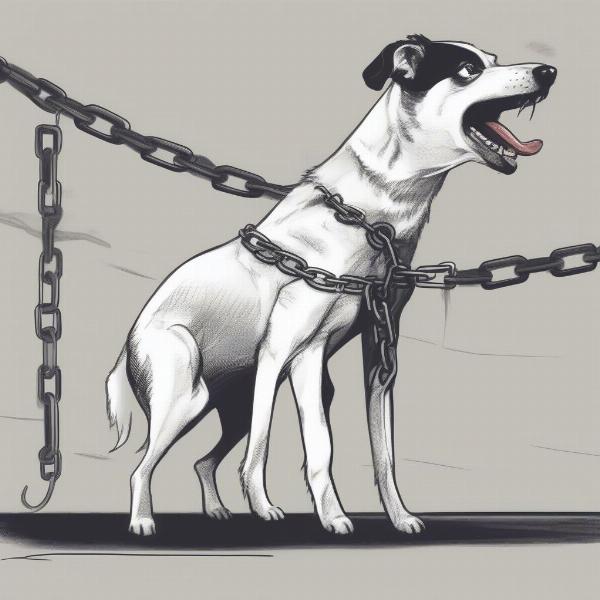Dog tie out chains are a common tool used to give dogs some outdoor freedom while still maintaining a level of control. However, their use comes with important considerations for a dog’s safety, well-being, and behavioral development. This article will delve into the responsible use of dog tie out chains, covering everything from selecting the right chain to addressing potential behavioral issues.
Choosing the Right Tie Out Chain
Selecting the appropriate tie out chain is crucial for your dog’s safety and comfort. The chain’s length should allow your dog adequate space to move around and explore without being able to reach hazardous areas or escape your property. Consider your dog’s size and breed when determining the appropriate length. A heavier chain is suitable for larger, stronger breeds, while a lighter chain is better suited for smaller dogs. Avoid chains that are too thin or flimsy, as these can break easily. Opt for rust-resistant materials like stainless steel or coated metal to withstand outdoor elements. The clasp should be secure and durable to prevent accidental unhooking. A swivel attachment is also beneficial as it prevents the chain from becoming tangled.
Potential Hazards and Safety Precautions
While tie out chains offer a convenient way to give your dog some outdoor time, they can present certain hazards if not used responsibly. Never leave your dog unsupervised on a tie out chain for extended periods. Regular checks are essential to ensure they haven’t become entangled or injured. Ensure the chain is securely attached to a sturdy object that won’t break or tip over. Trees, posts, or specially designed tie-out stakes are good options. Provide access to shade and fresh water to prevent overheating and dehydration, especially during hot weather. Keep the tie-out area clear of any potential hazards such as poisonous plants, sharp objects, or other debris. chain tie out for dogs
Behavioral Considerations and Training
 Hành vi của chó khi sử dụng dây xích buộc chó
Hành vi của chó khi sử dụng dây xích buộc chó
Using a tie out chain can sometimes lead to behavioral issues if not managed correctly. Dogs confined to a limited space can become frustrated or territorial, potentially leading to increased barking or aggression. It’s essential to socialize your dog and provide ample opportunities for off-leash exercise and interaction. correction collars for small dogs Never use a tie out chain as a substitute for proper training and socialization. Instead, consider it a temporary solution for controlled outdoor access. Consistent training and positive reinforcement can help your dog adjust to the tie out chain and minimize any potential behavioral problems. “A well-socialized dog is less likely to exhibit negative behaviors while on a tie-out,” says Dr. Emily Carter, a certified veterinary behaviorist.
Alternatives to Tie Out Chains
While tie out chains can be useful in certain situations, exploring alternative solutions is always recommended for a dog’s overall well-being. Fenced yards provide the best option, allowing dogs to roam freely and safely. If a fenced yard isn’t feasible, consider using a long lead attached to a harness for supervised outdoor playtime. “Providing ample opportunities for off-leash exercise and mental stimulation is crucial for a dog’s physical and emotional health,” adds Dr. Carter. clifford big red dog toys Remember, a tie-out chain should be used responsibly and never as a long-term solution for confinement. dog paw print stamp
Conclusion
Dog tie out chains can be a valuable tool for providing dogs with supervised outdoor time when used responsibly. By choosing the right chain, taking necessary safety precautions, and addressing potential behavioral issues, you can ensure your dog’s well-being while using a tie out chain. Prioritize your dog’s safety and happiness by considering alternatives and always opting for a well-balanced approach to their care. natural dog wormer
FAQ
- How long can I leave my dog on a tie-out chain? Never leave your dog unsupervised for extended periods. Regular checks are essential.
- What is the best material for a tie-out chain? Rust-resistant materials like stainless steel or coated metal are ideal.
- Can I use a tie-out chain for training? No, a tie-out chain should not be used as a substitute for proper training.
- What are some alternatives to tie-out chains? Fenced yards and long leads with harnesses are great alternatives.
- My dog barks excessively while on the chain. What should I do? This could be due to frustration or territorial behavior. Consult a veterinarian or professional dog trainer.
- Is it cruel to use a tie-out chain? It’s not inherently cruel, but improper or excessive use can negatively impact a dog’s well-being.
- What should I do if my dog gets tangled in the chain? Supervise regularly and ensure the tie-out area is free of obstacles.
About ILM Dog
ILM Dog is your trusted resource for all things dog-related. We offer expert advice on dog breeds, health, training, nutrition, grooming, and much more. Our goal is to empower dog owners worldwide with the knowledge and resources they need to provide the best possible care for their canine companions. Whether you’re a seasoned dog owner or just starting out, ILM Dog is here to guide you every step of the way. Contact us at [email protected] or +44 20-3965-8624 for expert advice on dog care, training, and product recommendations.